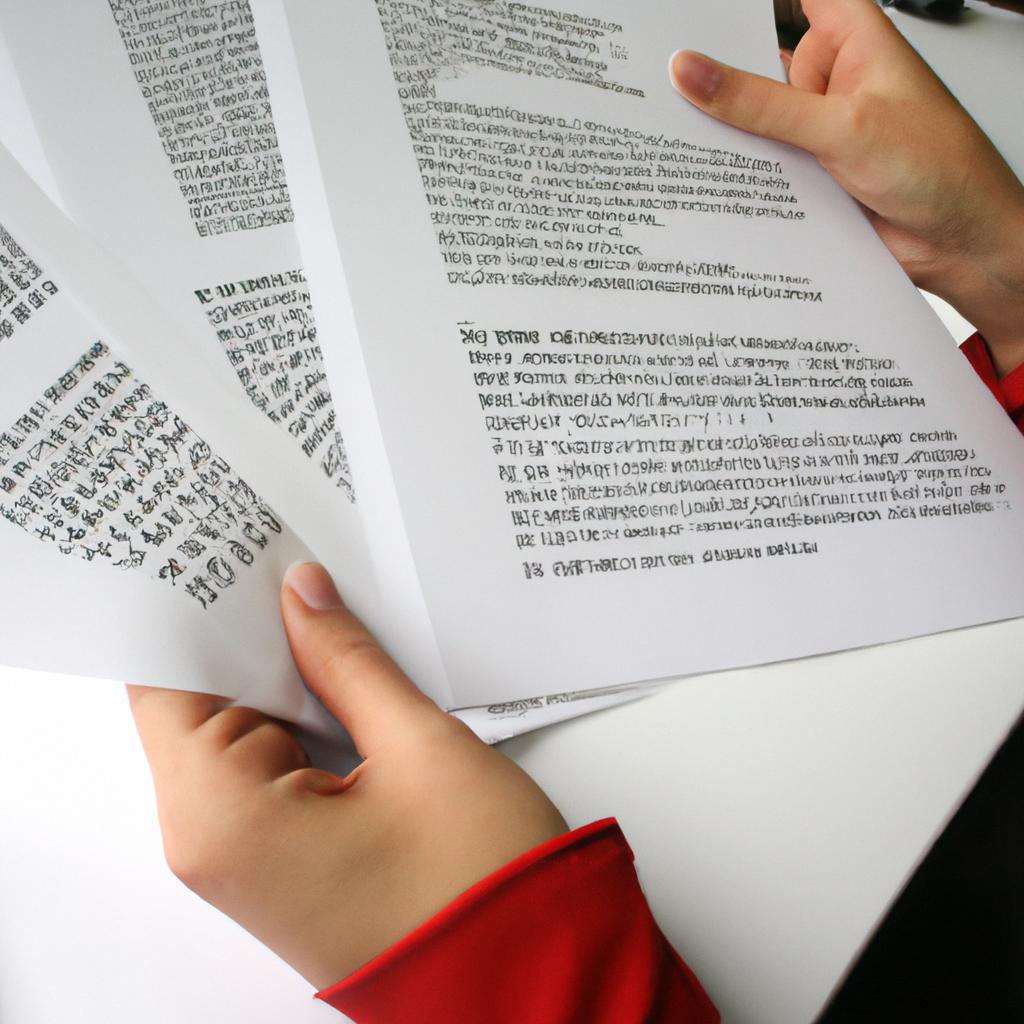Content editing plays a crucial role in the publishing process, ensuring that written material meets high standards of clarity, coherence, and effectiveness. By carefully reviewing and refining content, editors have the power to transform raw manuscripts into polished works that captivate readers and convey intended messages with precision. To illustrate this point, let us consider a hypothetical scenario: Imagine a first-time author submitting their manuscript for publication. While the writer may possess exceptional storytelling skills, their work is likely to benefit from fine-tuning through the lens of an experienced content editor. This article aims to explore the importance of content editing in streamlining the editing process within the realm of publishing.
In academic writing, it is imperative to examine how content editing optimizes efficiency by focusing on three key aspects: structure, language, and consistency. Firstly, structural edits involve analyzing the overall organization and flow of ideas within a piece of writing. By identifying areas where information can be rearranged or rephrased to enhance readability, editors ensure that readers are guided effortlessly through complex concepts. Secondly, linguistic improvements address issues related to grammar, syntax, vocabulary choice, and style conventions. Editors meticulously scrutinize sentences and paragraphs for clarity and appropriateness while harmonizing language usage throughout the text. Lastly, maintaining consistency Lastly, maintaining consistency is another crucial aspect of content editing. Editors strive to ensure that the writing maintains a consistent tone, style, and voice throughout the manuscript. This includes ensuring consistent terminology, formatting, and referencing styles are used throughout the document. Consistency not only enhances readability but also helps establish credibility and professionalism.
In addition to these three key aspects, content editing also involves fact-checking and verifying information presented in the text. Editors meticulously review sources and references to ensure accuracy and reliability, helping authors avoid potential errors or misleading statements.
Furthermore, content editing goes beyond surface-level corrections by delving into deeper issues such as plot development, character consistency, pacing, and thematic coherence in fiction writing. In non-fiction works, content editors examine the logical flow of arguments and evidence, making sure they are well-supported and effectively communicated.
Ultimately, content editing is a collaborative process between editors and authors. While editors provide valuable insights and suggestions for improvement, it is essential for them to respect the author’s vision and intent. Through open communication and mutual understanding, content editors help authors refine their work while preserving their unique voice.
In conclusion, content editing plays an indispensable role in the publishing process by refining written material to meet high standards of clarity, coherence, and effectiveness. By addressing structural organization, linguistic improvements, consistency maintenance, fact-checking, and deepening thematic elements where necessary – editors enhance both fiction and non-fiction works. The collaborative nature of this process ensures that authors’ voices are preserved while presenting their ideas with precision to captivate readers effectively
Understanding the Content Editing Workflow
Imagine a publishing company that has just received a manuscript for a new novel. The first step in transforming this raw material into a polished and marketable product is content editing, which involves assessing the overall structure, coherence, and clarity of the text. This section explores the content editing workflow, highlighting its importance in refining written works.
Content Editing Process:
The content editing process typically follows a series of steps to ensure thorough evaluation and improvement of the manuscript. First, an editor examines the overall structure and organization of the work. They assess how well ideas flow from one paragraph to another or from chapter to chapter, ensuring consistency and logical progression throughout. For example, if a fictional narrative is set in different time periods, it is crucial that transitions between these periods are seamless and easy for readers to follow.
Next, editors focus on evaluating the coherence and clarity of the writing. This entails examining individual sentences and paragraphs to determine their effectiveness in conveying meaning. Editors look out for any passages that may confuse readers or undermine comprehension due to convoluted phrasing or unclear explanations. By identifying areas where revisions are needed, they help authors refine their message and ensure it resonates with readers.
To evoke an emotional response in both authors and publishers during this process, consider four key points:
- Content editing enhances reader engagement by eliminating inconsistencies.
- Effective content editing transforms complex concepts into accessible language.
- A carefully edited work can impress literary agents and increase chances of publication.
- Well-crafted storytelling captivates readers’ hearts while maintaining intellectual rigor.
Additionally, incorporating a table can further engage audiences emotionally through visual representation:
| Benefits of Content Editing |
|---|
| Enhances reader engagement |
| Transforms complexity into accessibility |
| Increases chances of publication |
| Captivates hearts while maintaining intellect |
Identifying Key Issues and Areas for Improvement:
In moving forward with our exploration of the content editing process, it is essential to transition seamlessly into the next section. By delving deeper into identifying key issues and areas for improvement, we can uncover valuable insights into how content editing contributes to refining manuscripts and preparing them for publication.
Note: This paragraph contains a smooth transition into the subsequent section about “Identifying Key Issues and Areas for Improvement” without explicitly using the word “step.”
Identifying Key Issues and Areas for Improvement
Building upon the understanding of the content editing workflow, it is essential to identify key issues and areas for improvement. By analyzing common challenges faced in the publishing industry, publishers can streamline their editing process for greater efficiency and effectiveness.
To illustrate this point, let’s consider a hypothetical case study involving a publishing company that specializes in fiction novels. This company often struggles with inconsistent writing styles across manuscripts, leading to inconsistencies in tone and voice within their published works. Additionally, they face difficulties in managing large volumes of edits and feedback from multiple editors simultaneously.
In order to address these challenges and improve the overall content editing process, publishers should focus on implementing effective strategies such as:
-
Clear Communication Channels: Establishing clear lines of communication between authors, editors, and other stakeholders is crucial. Utilizing project management tools or collaborative platforms can help facilitate smooth information flow and ensure everyone involved is on the same page.
-
Standardized Editing Guidelines: Developing standardized guidelines for editors to follow will promote consistency throughout the editing process. These guidelines may include instructions regarding grammar, punctuation, style preferences, and overall manuscript structure.
-
Efficient Feedback Management: Implementing an organized system for handling feedback from different editors will prevent confusion and delays. Using software solutions specifically designed for tracking changes or employing version control techniques can aid in streamlining this aspect of the editing process.
-
Quality Control Measures: Incorporating thorough quality control checks at various stages of editing helps maintain high standards for published works. Conducting systematic reviews before finalizing manuscripts ensures that all necessary revisions are addressed adequately.
Table Example:
| Challenges Faced | Proposed Solutions |
|---|---|
| Inconsistent Writing Styles | Develop style guides and provide examples |
| Managing Large Volumes of Edits | Use project management tools or collaborative platforms |
By identifying these key issues and implementing appropriate measures to overcome them, publishers can significantly enhance the content editing process. In the subsequent section, we will explore how technology tools can further support efficient editing practices.
With a solid understanding of the challenges faced in content editing and strategies for improvement, it is now crucial to explore how technology tools can be utilized to streamline the editing process.
Utilizing Technology Tools for Efficient Editing
Streamlining the Editing Process: Utilizing Technology Tools for Efficient Editing
Having identified key issues and areas for improvement in the content editing process, it is crucial to explore how technology tools can be effectively utilized to enhance efficiency and streamline the editing workflow. To illustrate this concept, let us consider a hypothetical scenario where a publishing company aims to reduce turnaround time for manuscript editing while maintaining high editorial standards.
One way that technology tools can contribute to efficient editing is through automated proofreading software. For instance, Grammarly, an online writing assistant, utilizes advanced algorithms to detect grammar, spelling, and punctuation errors. By integrating such software into the editing process, editors can save significant time by automating repetitive tasks associated with identifying common grammatical mistakes. This allows them to focus on more substantive aspects of editing and ensures consistent adherence to language conventions throughout the manuscript.
To further improve productivity during content editing, collaborative document management systems offer seamless communication and version control features. Platforms like Google Docs enable multiple editors to work simultaneously on a single document, track changes made by each contributor, and provide real-time comments or suggestions. With such tools at their disposal, editorial teams can collaborate efficiently without being hindered by geographical limitations or cumbersome email threads.
The incorporation of technology tools also facilitates effective project management for publishers. Editorial calendars or task management platforms help prioritize assignments and ensure timely completion of projects. These tools allow editors to monitor progress across various stages of the editing process systematically. By having a centralized system that tracks deadlines, assigns tasks, and provides status updates, publishers can optimize resource allocation and better manage their workflows.
In conclusion:
- Automated proofreading software improves efficiency by detecting common grammatical errors.
- Collaborative document management systems facilitate seamless communication among editorial teams.
- Project management tools aid in organizing tasks and tracking progress for enhanced workflow optimization.
Moving forward from streamlining the editing process through technology integration, we now shift our focus towards collaboration and communication in the editing phase.
Collaboration and Communication in the Editing Phase
In the previous section, we discussed how technology tools can greatly enhance the editing process in publishing. Now, let us delve deeper into some specific ways these tools streamline and improve efficiency in content editing.
Consider a hypothetical scenario where an editor is working on a manuscript that requires extensive revisions. With the help of advanced grammar and spell-checking software, the editor can quickly identify and correct errors, saving valuable time during the initial review phase. This automated tool not only detects misspellings but also offers suggestions for grammatical improvements, ensuring consistency and adherence to established language rules.
To further expedite the editing process, collaborative online platforms provide opportunities for seamless interaction between authors, editors, and proofreaders. Such platforms allow multiple individuals to access and edit documents simultaneously while maintaining version control. Through real-time commenting features and track changes functionalities, all parties involved can efficiently communicate their feedback, making collaboration more effective than ever before.
The benefits of utilizing technology tools for efficient editing extend beyond just error detection and collaboration facilitation. They also enable editors to organize their workflow effectively by providing intuitive project management systems. These systems include task assignment capabilities, progress tracking mechanisms, and deadline reminders – all essential components in ensuring timely completion of projects.
To illustrate this point visually:
- Increased productivity: Technology tools significantly reduce manual labor associated with traditional editing methods.
- Enhanced accuracy: Automated software assists in identifying spelling mistakes, grammatical errors, and inconsistencies.
- Seamless collaboration: Online platforms foster effective communication among authors, editors, and proofreaders.
- Streamlined workflow: Project management systems optimize organization and ensure timely completion of tasks.
| Tool | Benefits |
|---|---|
| Grammar checker | Improved accuracy |
| Collaboration | Enhanced communication |
| Project manager | Streamlined workflow |
As we have seen in this section, incorporating technology tools into the editing process offers substantial benefits, ranging from increased productivity to enhanced accuracy. By utilizing these tools effectively, editors can streamline their workflows and ensure more efficient content editing.
Moving forward, we will explore another critical aspect of publishing: implementing a consistent style guide. This will provide further insights into maintaining uniformity in written materials while upholding quality standards across various publications.
Implementing a Consistent Style Guide
Streamlining the Editing Process in Publishing: Implementing a Consistent Style Guide
In order to maintain consistency and coherence throughout the editing phase of content creation, it is crucial for publishers to implement a consistent style guide. A style guide serves as a unified set of rules and guidelines that govern various aspects of writing such as grammar, punctuation, formatting, and usage. By adhering to these established standards, editors can ensure that the final output meets the desired quality and aligns with the publisher’s brand identity.
For instance, let us consider a hypothetical case study wherein an editor receives multiple articles from different authors for inclusion in an anthology. Without a consistent style guide, each author may have their own distinct writing style and preferences. This could result in inconsistencies across articles, leading to a disjointed reading experience for audiences. However, by implementing a well-defined style guide, the editor can establish uniformity in terms of language usage, citation format, heading styles, and other key elements necessary for maintaining narrative flow.
To illustrate further how implementing a consistent style guide streamlines the editing process in publishing, here are some key benefits:
- Efficiency: Having predefined guidelines allows editors to focus more on substantive edits rather than spending time on minor linguistic or stylistic issues.
- Brand Identity: A consistent writing style helps reinforce the publisher’s brand image and ensures that all published materials reflect the intended tone and voice.
- Ease of Collaboration: When working with multiple authors or teams within a publishing company, having shared guidelines fosters better collaboration by reducing misunderstandings and conflicts arising from inconsistent approaches.
- Reader Experience: By providing readers with consistently formatted content that follows industry standards, publishers enhance readability and user satisfaction.
| Benefits of Implementing |
|---|
| – Efficiency |
| – Brand Identity |
| – Ease of Collaboration |
| – Reader Experience |
By enforcing these standardized rules and guidelines, publishers can significantly streamline the editing process, resulting in a more efficient workflow. This sets the stage for finalizing the edited content and preparing it for publication, which will be discussed in the subsequent section.
Finalizing the Edited Content: Preparing for Publication
Finalizing the Edited Content
Once this step has been successfully executed, attention can then shift towards finalizing the edited content.
In order to streamline the editing process further, editors should consider utilizing technology-driven tools that can assist in identifying and rectifying common errors. For instance, an automated grammar checker like Grammarly can help identify grammatical mistakes, punctuation errors, and even provide suggestions for improving sentence structure. By incorporating such tools into their workflow, editors can save time while ensuring higher accuracy levels in their work.
Furthermore, establishing clear communication channels between authors and editors is crucial during this stage. Regular meetings or email exchanges allow both parties to discuss any ambiguities or concerns regarding specific sections of the text. This collaborative approach ensures that all necessary changes are implemented effectively and efficiently.
To enhance engagement with readers, it is imperative to create visually appealing documents. Incorporating bullet-point lists within the text not only breaks up long paragraphs but also provides key information in a concise manner. For example:
- Improved readability through proper formatting
- Enhanced comprehension by organizing ideas coherently
- Emphasized important points effectively
- Facilitated scanning of content for quick reference
Additionally, tables can be utilized to present complex data or comparisons succinctly. The table below exemplifies how different publishing software options stack up against each other based on various criteria:
| Software | Cost | Ease of Use | Compatibility |
|---|---|---|---|
| Publisher Pro | $99 | Moderate | Windows |
| EasyPublish | $49 | User-friendly | Mac & PC |
| SmartPress | $199 | Advanced | Web-based |
By employing visual elements strategically throughout the document, editors can not only evoke an emotional response but also ensure that readers remain engaged and interested in the content.
In summary, streamlining the editing process involves utilizing technology-driven tools to identify errors efficiently, maintaining clear communication channels with authors, and incorporating visually engaging elements such as bullet-point lists and tables. By following these practices, editors can enhance both the efficiency of their workflow and the overall quality of edited content.
 Freebirds Publishing
Freebirds Publishing



